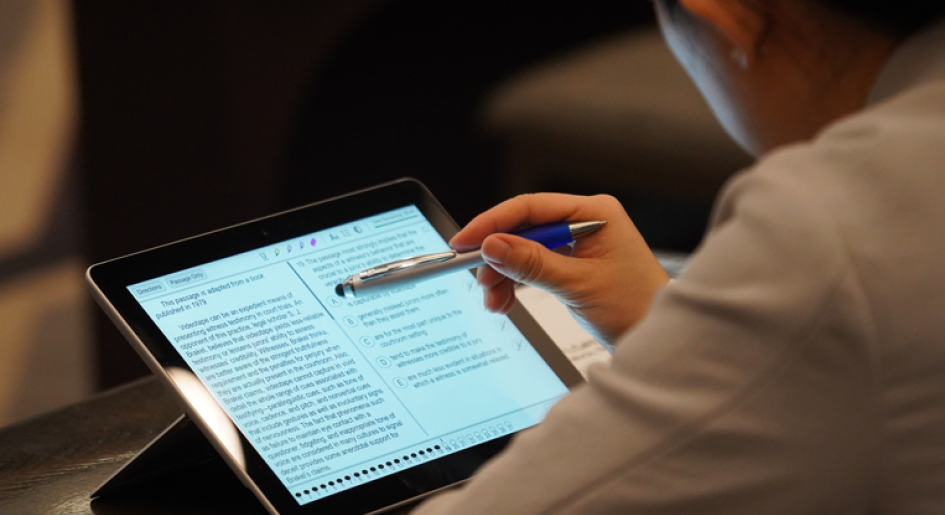
Countdown to the Digital LSAT, Part 2: Greater Accessibility, Help with Test Prep, and More
On Monday, July 15, thousands of aspiring law students will participate in the first administration of the Digital LSAT. In my earlier blog post, I talked about how the Digital LSAT came to be, and some of the most important elements and benefits of the new format. Today, I want to cover some of the key nuts and bolts of what the digital format will mean for test takers.
When will scores be available?
Since the July 2019 LSAT is being administered in two different formats, it will take longer than usual for test takers to receive their scores. First, we need to get the data from hundreds of test centers all across the U.S. and Canada back to LSAC and processed, which normally takes several weeks. After that, our measurement scientists and researchers will begin analyses and research studies for comparing paper test data and digital test data. This part of the process is a standard practice whenever a new test format is introduced. Scores will be reported after that work is complete. Future test administrations will not require such extensive comparison studies, so test takers will receive their scores faster.
We know that test takers are eager to get their scores as soon as possible. We also know from test-taker feedback that it’s important to announce in advance exactly when scores will be delivered, so they don’t have to deal with uncertainty or constantly checking to see when scores will be available. As a result, we are announcing that scores will be available to test takers at 9:00 a.m. Eastern Time on Wednesday, August 28. This date will allow test takers who have registered for the September 21 test to decide whether they want to cancel, based on their July result. This date will also allow July test takers who want to re-test to register for the October 28 exam, as registration for that exam is open until September 10.
We plan to move to the digital test format for the vast majority of North American test takers, effective with the September 21 LSAT. Of course, we will also ensure that any test takers with documented special requirements are appropriately accommodated.
Overwhelming Demand
Due to the unique nature of the July test where test takers won’t know in advance, for research purposes, whether they are getting the paper-and-pencil test or the digital test, scores will take longer than normal to report due to the analysis described above.
To address these issues, we decided to provide a unique opportunity to July test takers. For the July test only, all test takers will have the opportunity to see their scores, then have five business days in which to cancel their score. Anyone who cancels their July test score will have the option to take a free LSAT any time through the April 2020 test administration. Normally, test takers are not allowed to see their scores before deciding whether to cancel.
Specifically, for the July test only, all test takers will have the opportunity to see their scores and will have until Wednesday, September 4, at 11:59 p.m. Eastern Time to cancel their scores. Test takers will be able to access their scores from any internet-connected device, including smartphones.
As noted above, we initially worried that people might take a wait-and-see attitude to the July test. In the end, the response to the July test has been overwhelming — more than 28,400 registered test takers. We are excited by the huge volume, and it will provide a great launch for the digital test.
Helping Test Takers Prepare
Our field testing has shown that test takers find the Digital LSAT very easy to use. The structure of the test sections and test questions will not be any different than the paper-and-pencil format.
To help test takers prepare, we created a free Get Acquainted with the Digital LSAT site that includes tutorials that show how the tablet test works and several full digital practice tests that test takers can use to become more familiar with the tools and features they will use on the day of the test. Prospective test takers can access the site on a laptop, desktop computer, or tablet. To better emulate the experience of taking the Digital LSAT, prospective test takers may wish to access the “Get Acquainted” site on a tablet, though any internet-connected device will work. On non-touchscreen devices, prospective test takers can use a mouse or trackpad to get comfortable with the Digital LSAT’s features so that they are familiar with them on test day.
The Law School Admission Council also offers free Official LSAT Prep through Khan Academy, which provides an excellent way to practice for the LSAT in a digital environment. Over 40,000 unique users are accessing this free LSAT prep from the Khan Academy website each month.
Ensuring Accessibility for All Test Takers
While we’re proud of the Digital LSAT’s many built-in accessibility features, we recognize that some test takers may need other accommodations to access the Digital LSAT. Accommodations that traditionally have been available on the LSAT remain available on the Digital LSAT in accordance with LSAC’s stated policies and procedures for testing accommodations.
The next six weeks will be an exciting time for all of us at LSAC, as we prepare to launch the Digital LSAT. If you are a prospective test taker, we encourage you to use all the familiarization tools we’ve provided, and make sure you are comfortable with how the digital test works. Be prepared so you can do your best work. Try it out; we think you will like what you find.

